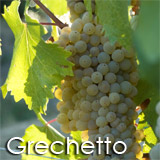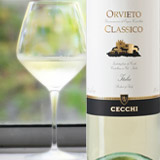Grechetto or Grechetto Bianco is an Italian white wine grape of Greek origins. The grape is planted throughout central Italy, particularly in the Umbria region where it is used in the DOC wine Orvieto as well as the DOCs of Torgiano and Colli Martani. It is primarily a blending grape, though some varietal wine is also produced. Grechetto is commonly blended with Chardonnay, Malvasia, Trebbiano and Verdello - where Grechetto can add herbal and nutty flavours to the wine. The grape's thick skin provides good resistance to downy mildew which can attack the grape late in the harvest season. This makes Grechetto a suitable grape in the production of Vin Santo - where the grapes are dried extensively before vinification.
The grape has been developing more of a presence as winemakers are finding more potential in the grape than in the other main Umbria white grape varieties Drupeggio and Trebbiano. Outside Umbrian borders, Grechetto is almost exclusively used together with other grapes, whereas in its homeland it is frequently used for the production of simple varietal wines.
Research seems to have found the Grechetto known in Umbria is genetically similar to Pignoletto grape known in Emilia Romagna and to Ribolla Riminese. Recent research using DNA analysis, have established the identity of Greek Todi, Pignoletto and Ribolla Rimini, while the wines seem to be profoundly different to the Grechetto of Orvieto.
The thick skin of Grechetto allows the grape to be harvested late with high sugar levels. This works well in the production of dessert wines. There are at least two sub-varieties of Grechetto-Grechetto di Todi and Grechetto Spoletino with the former being more widely planted. The Grechetto vine is low yielding and able to produce concentrated flavours. Oak is used for wines in which Grechetto is blended with Chardonnay; however youcan find 100% Grechetto wines fermented or aged in cask or barriques. It should however be mentioned that the majority of wine is vinified in stainless steel or cement.










